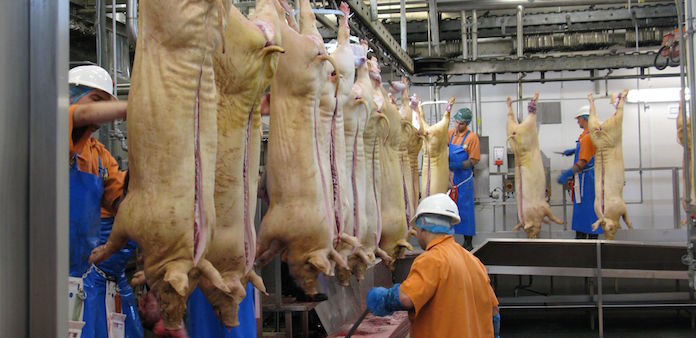Russian pig farmers’ profitability has been falling steadily since 2015, when, driven by the food embargo, domestic prices were skyrocketing, Yuri Kovalev, chairman of the National Union of Pig Producers (NUPP) has admitted.
From an unprecedented 45% back then, profitability is now down to 15%, as investors, inspired to put their money into pig farming on the back of this profitability, have increased domestic output from 3 million tonnes to 3.4m t, almost closing the gap between production and demand.
This is not even the peak of the problem, as new pig farms with a combined capacity of around 700,000t of pork will come into operation by 2020, putting supply at odds with the estimated domestic demand of 3.55m t, the NUPP has warned.
A recently introduced ban on Brazilian imports should come in handy – 200,000t entered Russian from Brazil in 2017, primarily the cheapest cuts and trimmings. The Russian Agricultural Ministry claims the ban shouldn’t spark a domestic price hike – but the NUPP believes it will slow down the ‘inevitable’ fall in prices in the coming years.
Meanwhile, on December 6 Russia lifted its veterinary ban on imports of pork and live pigs from the EU. Technically, this means EU pork is a step closer to returning to the Russian market, as the political ban, or food embargo, remains the only obstacle in its way now. However, it is hard to imagine that, after fighting for better self-sufficiency on pork over all these years, the Russian government will now remove restrictions completely.
Indeed, Eugeny Savchenko, the governor of Belgorod Oblast, the major Russian pork-producing region, has estimated the EU pork purchase price is 200% lower than in Russia – so lifting the embargo would have harsh consequences for Russian farmers. EU imports were once worth €1.4 billion a year and it is highly unlikely that, as he seeks a fourth term in March, president Vladimir Putin will break his promise to pig farmers ‘to keep the embargo in place for as long as possible’.
ASF vaccine silence
The oversupply crisis is only one factor affecting the profitability of pig farming in Russia. The other important issue is, of course, African swine fever (ASF).
Back in 2007, when the virus had only just arrived in Russia, scientists from several leading laboratories claimed they would be able to develop a vaccine. It was expected in 2018 and, in 2014, the Research Institute of Veterinary Virology and Microbiology reported that it had developed a vaccine.
However, vaccinated pigs with ASF were not dying but were becoming carriers of the virus. The scientists promised to resolve this problem, but as they have remained silent about this development in recent years it seems that they were not able to succeed.
Recent data has revealed around 160 outbreaks were registered across 24 regions in 2017, compared with almost 300 in 20 regions in 2016. Speaking in November, Agricultural Minister Alexander Tkachev said the most worrying development last year was that ASF had reached Siberia.
He forecast that, at the current rate of spread, it would soon reach permafrost regions, such as the Republic of Yakutia, before heading for the far east of Russia. Of perhaps more concern is the fact that ASF-infected wild boars are regularly crossing over the Ukranian border into the previously unaffected Belgorod Oblast, where three outbreaks were reported last year.
It seems the Russian Government now doesn’t have a comprehensive programme to combat ASF. A plan to kill wild boars has been met with a stinging backlash from environmental organisations. An attempt to ban backyard farming because of poor biosecurity has also failed, ruled by the courts as a breach of people’s basic rights.
And a proposal to unite the two Russian bodies in charge of veterinary and sanitary control, supported by NUPP, looks unlikely to happen after veterinary officials opposed it. A federal strategy had been discussed, but has not been on the table for some time: primarily because it is not clear what measures could be laid down to form the basis of a strategy.




